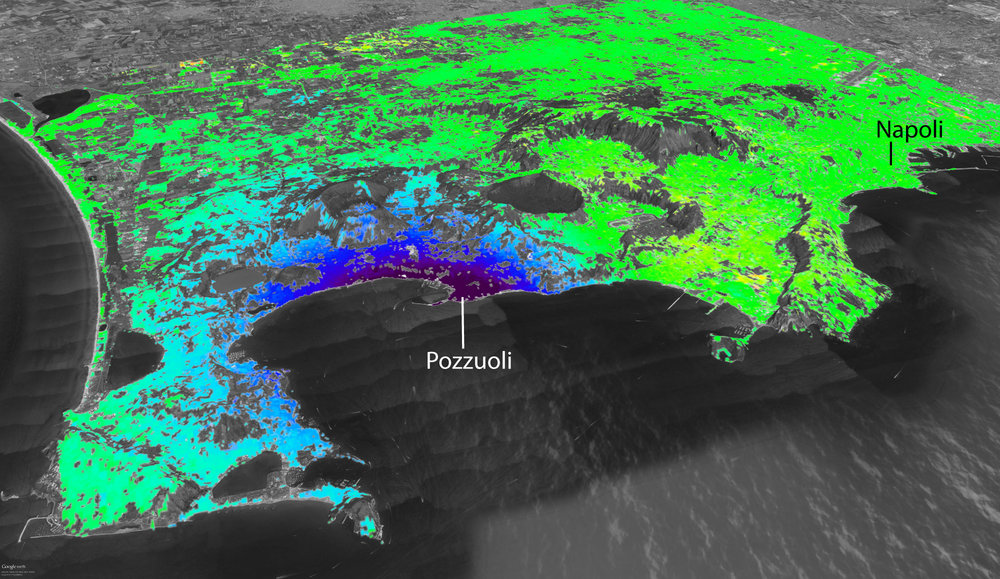A new technique can calculate, through Satellites and GPS data, how the deep magma goes up inside the ground of Campi Flegrei, creating even millimeter deformations of the Earth's surface. A mechanism probably common to other calderas (Yellowstone in the US and Rabaul in Papua New Guinea). The study, published in Scientific Reports, provides new monitoring systems useful to deal with possible future volcanic crises.
The data acquired from satellites and GPS receivers of the network of sensors placed in the Campi Flegrei area are used to monitor the Earth's surface deformations and to know, in real time, the trend of the ground uplift in the caldera. This is the new monitoring technique developed by a team of researchers from the Institute for Electromagnetic Sensing of the Environment of the National Research Council (CNR-IREA) and the Vesuvius Observatory of the National Institute of Geophysics at Volcanology (INGV- OV), in order to better understand the uplift phenomena occurred in recent years at Campi Flegrei. The study, which is part of the monitoring activities promoted by the Italian Department of Civil Protection (DPC) and those undertaken under the European project MED-SUV (MEDiterraneanSUpersite Volcanoes), was published in Scientific Reports.
"Thanks to the data acquired by the Cosmo-SkyMed satellites (launched by the Italian Space Agency since 2007), equipped with radar systems, and by GPS receivers of the INGV-OV geodetic surveillance network, composed by 14 sensors spread in the Campi Flegrei area", says Susi Pepe, researcher at CNR-IREA," it has been possible to study the deformations, even millimetric, of the Earth's surface and know the trend of the ground uplift in the caldera in correspondence to the receivers".
In the past millennia the Campi Flegrei caldera produced eruptions of gigantic dimensions: forty thousand years ago the Campanian ignimbrite and fifteen thousand years ago the Neapolitan Yellow Tuff, which made the superficial part of the volcano collapse for hundreds of meters, forming the current structure. "After the last eruption in 1538 that produced the Monte Nuovo crater", says Luca D'Auria, the researcher in charge of the Vesuvius Observatory monitoring room, "the ground of the Campi Flegrei began to sink slowly for centuries, untill around 1950, when the area started to raise. This phenomenon, known as bradyseism, showed all its violence between 1982 and 1985, the period when the ground raised almost 2 meters, with accompanying earthquakes, resulting in the evacuation of thousands of residents of the town of Pozzuoli. In 2005 the ground restarted to rise slowly and earthquakes, of low magnitude, reappeared."
Over the past 10 years, the ground has risen almost 30 cm., so much so that in December 2012, based on indications of the Commission Great Risk, the Civil Protection raised the alert level of Campi Flegrei from green (repose) to yellow (warning). "Regarding the origin of the flegrean bradyseism" continues D'Auria, "the scientific community agrees that between 1985 and 2012 the ground uplift was linked to the placing of hydrothermal fluids (water and gas) within the caldera rocks and the progressive heating of the latter. About the most recent episode, between 2012 and 2013, the phenomenon would instead be attributed to the rise of magma at shallow depth (approximately 3 km) that is injected into the subsurface rocks, forming a thin layer, known as the sill, a small "lake underground", with a radius of 2-3 km. The sill was already in the ground and it was probably active during the bradiseismic crises of the past decades when amount of magma, even ten times higher, arrived in this small shallow magma chamber."
The magma within the sill, however, can cool down quickly, thus making it less able to produce explosive eruptions. This mechanism, observed at Campi Flegrei, is probably common to other calderas (for example, Yellowstone in the US and Rabaul in Papua New Guinea) and may explain some behaviors apparently 'bizarre' observed in these volcanoes. "The predictions of volcanic eruptions in the calderas often presents greater difficulties than other volcanoes" adds D'Auria. "The lift and the intrusion of magma within the sill may, in fact, be the normal life cycle of the calderas."
The results of the study are of great importance for the interpretation of the data acquired by the new generations of satellites (like those of the constellation Sentinel of the European Program Copernicus, carried out by the European Space) and the innovative technologies of geophysical monitoring at Campi Flegrei. "These new monitoring systems, integrated with the new methods of analysis, may provide a useful tool to address possible, future volcanic crises at Campi Flegrei" says Susi Pepe at CNR.
Link to the article: www.nature.com/articles/srep13100




